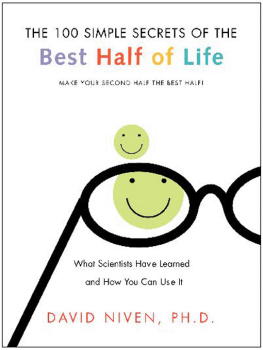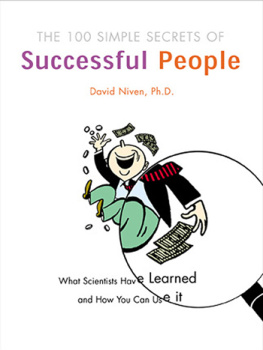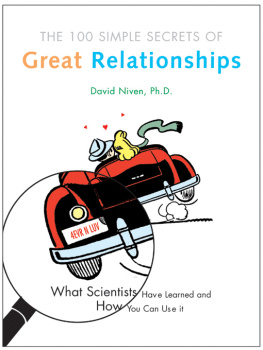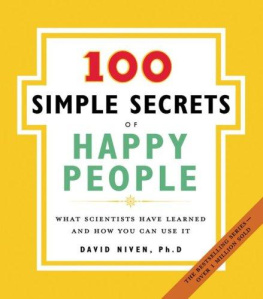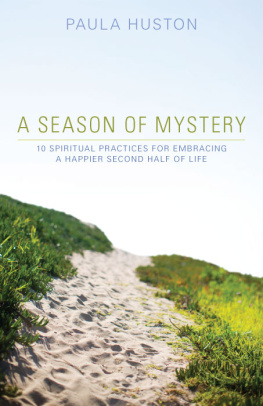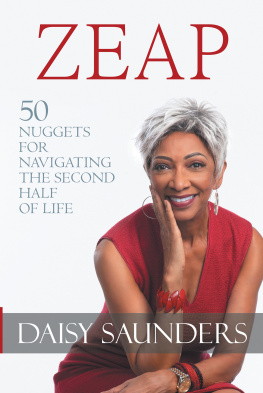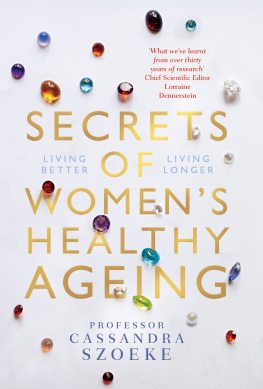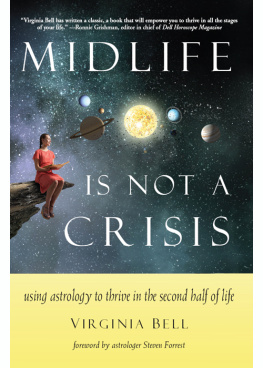My thanks to Gideon Weil, Miki Terasawa, Claudia Boutote, Stephen Hanselman, and the many good folks at Harper-SanFrancisco who have worked with me on this book, and to my agent, Sandy Choron. They have helped to make this book a more useful tool for readers, and I offer them my sincere appreciation.
Each of the one hundred entries presented here is based on the research conclusions of scientists studying the lives and habits of people in their fifties, sixties, seventies, eighties, and above. Each entry contains a key research conclusion complemented by advice, together with an example that illustrates the conclusion. The research conclusions I present in each entry are based on a meta-analysis of research, which means that each conclusion has been derived from the work of multiple researchers studying the same topic. To enable the reader to find further information on each topic, I have included in each entry a reference to a supporting study. And at the end of the book I have provided a list of sources on happiness over the course of a lifetime.
Nearing retirement after three decades of teaching elementary school students in Ohio, Cathy Martin was thinking a lot about her future. She thought about her plans and priorities for the next phase of her lifewhere she would live, whether she should work part-time, and where she might travel.
And, to the disappointment of a number of her fifth-grade students no doubt, her thoughts led her to what seemed an interesting and valuable essay assignment. What, she wondered, did her students imagine for their lives when they were in their fifties, sixties, and beyond? Cathy thought the idea of looking many decades ahead in their lives would interest her students and encourage them to think about how their education would contribute to their futures.
In reading the essays, Cathy learned a number of things. One thing is that almost everybody is convinced we will have some kind of spaceship car that doesnt need wheels and just flies wherever you want to go, Cathy reports.
The second thing is how much they focused on the action of life. They wrote less about having terrific accomplishments and more about actually doing something terrific. They wrote less about having a stack of money and more about having fun. They wrote less about wanting to have an easy life and more about wanting to have what you might call a full life.
We adults live our lives with starts and stops, Cathy says. We start working, we stop working, we start something else. Instead of seeing lots of endings and beginnings, the students saw continuation. They saw a far-off tomorrow as a continuation of today. Nobody wrote about stopping what they wanted to do. Nobody wrote about doing things they didnt think were valuable.
And the students, in writing about the far-off future, were future oriented even about that subject. They had plans for moremore action, more achievements, more life, she says. They live in a world where a seventy-seven-year-old man has been an astronaut. They dont see fifty or sixty or seventy as the end of anything at all.
Cathy noticed an absence of negatives in their essays as well: Nobody focused on disappointments or grudges. And, fortunately, nobody foresaw themselves fifty years later lamenting all the essays their fifth-grade teacher made them write.
Cathy took away a lot from the perspective of her students. They see themselves as hopeful, excitable, forward looking, and taking action, Cathy says. They were without dread, without lament, without surrender. And even if they are a bit unrealistic about life, isnt that a wonderful way to approach getting older?
Cathy resolved to take those lessons to heart, especially as she examined her attitude toward whats next in her own life: I see my future now more as a step forward instead of a whole new beginning. And I hope I can live up to the expectations of my students for their future livesexcept for the part about the space cars.
And in many ways, Cathys lessons from her students echo some of the most significant research conclusions scientists have drawn regarding happiness over the course of a lifetime. As I conducted the research for 100 Simple Secrets of the Best Half of Life, reading studies about the habits and practices that contribute to a satisfying life, I found many examples of the great importance of attitudes, perspectives, and a willingness to act. Each entry in 100 Simple Secrets of the Best Half of Life presents a core research conclusion, an example of the conclusion, and the basic advice experts recommend. I share these findings here for Cathy and for all of you, so that you can use the best scientific information we have to thrive in the best half of your life.
We have strategies for most things in our livesfrom work, to games, to how to get home from town two minutes faster. But we leave some of the most important parts of our lives, like our happiness, to chance. Happiness is not like height; you dont just get a certain amount and then have to live with it. Happiness can be improvedif you know what you are doing and what you are not doing, and you care to change.
For Patrick, it started with a request from a neighbor. The neighbor had played the part of Santa Claus for several years, creating a tradition of a visit from Santa to all the children in the neighborhood. But one year, Santa had a cold and asked whether Patrick could take over for him that day.
Patrick donned the suit and passed out candy canes and good wishes to all the neighborhood children, calling them each by name and convincing them he was for real. When I put on the suit, I actually felt like Santa Claus, Patrick says. It was a truly magical feeling.
When the old Santa saw how much Patrick enjoyed the job, he told Patrick he would be happy to let him take over. Patrick saw the potential for sharing some joy with others and expanded the reach of his duties from his neighborhood to area hospitals. Sick children would light up when they saw me, Patrick recalls. I would sit with them, and they would smile from ear to ear. It was such an honor to be able to bring them a good feeling like that.
Over the years the Santa suit wore out and Patrick upgraded to a top-of-the-line modelthe kind they use at the really good malls, he explains.
Patrick has been playing Santa for so long now that hes beginning to see the children of the children he saw as Santa when he first started out. But Patrick has no plans to find a new man for the suit. Santa never retires, he says.
Researchers found that the majority of the subjects they studied were not able to identify anything they had done recently to try to increase their happiness or life satisfaction.
Frijters 2000

